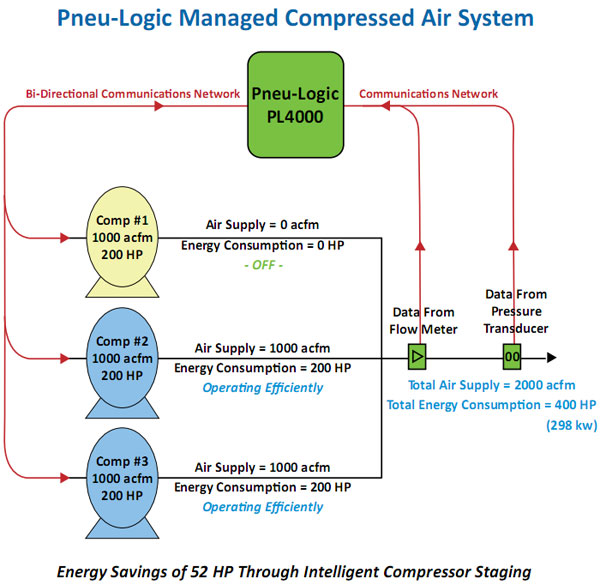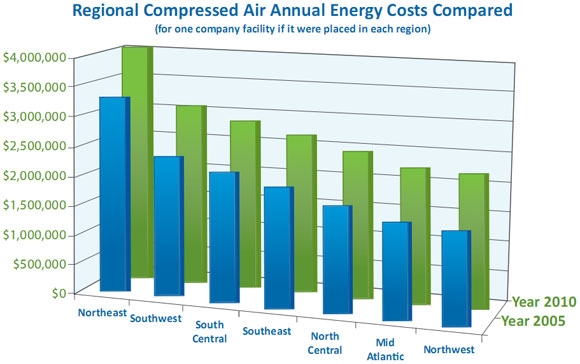FAQS
Ask away. We have the answers.
With our years of industry experience, we have found that some questions seem to be on everyone’s mind. We are happy to provide information, whether it be about Pneu-Logic technology, or compressed air systems in general. Simply click on any of the FAQ below to be directed to the corresponding answer.
- How important is the use of compressed air throughout global industry today?
- How much does industry utilize compressed air, and why?
- What is the most expensive cost of generating compressed air?
- What are the advantages of using Pneu-Logic's technology?
- What problems do companies face in generating compressed air?
- What does a simple Pneu-Logic management control system look like?
- Which is more important for efficient compressed air management ... air flow or air pressure?
- After more than 80 years, why is generating compressed air still so inefficient?
- Are new air compressor designs always more efficient than older models?
- How much effect do varying electrical energy rates have on actual compressed air costs?
Compressed air has been an essential utility resource for virtually every industrial, manufacturing, mining, assembly and processing facility in the world for over 80 years. Commonly referred to as the fourth utility, compressed air is the only one of the four major industrial utilities (electricity, water, gas, and compressed air) that end users must produce and manage themselves. With very few exceptions, companies generate compressed air by using electrically powered air compressors and related equipment which individually and collectively consume vast amounts of electrical energy in a very inefficient manner. Simply stated, generating this essential industrial compressed air is highly inefficient and under-managed, both as a production resource and from a financial perspective. Compressed air represents a substantial cost component of any manufacturing process. Compressed air continues to be an essential and mission critical part of virtually all industries, having an equally direct and often substantial effect on manufacturing productivity, process throughput and efficiency, quality control, and process waste. The chart below illustrates the amount of compressed air used by various industries (identified by US SIC codes):

The US Department of Energy (US DOE) conservatively estimates that more than 85% of US manufacturing, mining, processing, and industrial facilities of all types are dependent on the use of compressed air as an essential and mission critical part of their daily operational processes. Verified by many government and industry organizations, such as the US DOE and the British Compressed Air Society in the UK (BCAS), this huge dependency by all industries on compressed air systems is also true throughout the rest of the world at approximately the same 85% level. Compressed air is used for the overwhelming majority of industrial tasks because of its cleanliness, compact size and efficiency in physically driving hand tools and machines, and its relative safety compared to electricity and gas.
Few companies are aware that the largest cost element of generating compressed air over time (by far) is electrical energy. The US DOE calculates that over a ten year period, even at the relatively low fixed energy cost per year of $.05 per kWh (shown in the diagram below), electrical energy will cost the average industrial company 76% of their total compressed air system costs (including all capital expenditures). In other areas with higher electrical energy costs, this can approach 90% of total compressed air system costs! Pneu-Logic technology saves customers between 10% and 30% of their total industrial compressed air electrical energy and costs.

Pneu-Logic’s patented and well-proven automated control system uses advanced computer technology to dynamically monitor and manage compressed air demand and supply in real time for all compressor types, in all industries. Some advantages our customers see include:
- Consistent reduction of energy consumption and costs from 10% to 30%.
- Net productivity increases of between .5% and 1.5% because of more reliable delivery of compressed air to all machines and tools.
- Reduction in overall system air pressure requirements, thus reducing energy use and air leaks throughout the air delivery system.
- Performance in any mixed environment. Controls and manages all compressors (both positive displacement and centrufigal), regardless of OEM make, model, or manufacture date.
- Comprehensive and useful automated operating management reports.
- Integration directly (or indirectly) with other control or management computer systems.
- Self-documenting energy savings and power utilization greatly facilitates compliance with all Utility Company energy rebate programs and requirements.
- WAN, LAN or Internet system connectivity for remote access management and support.
Unlike any other utility used in industry, compressed air must be generated on-site, within limited proximity to its intended consumption. The compressed air generating process consumes huge amounts of electricity in a very inefficient manner. The US DOE states that the net relative system inefficiency of generating compressed air by electrical motors is approximately 8 electric motor horsepower = one horsepower of compressed air. Most importantly, according to the US DOE, is the fact that generating compressed air accounts for up to one-third of the total electric motor energy consumed by all industrial facilities in North America, and equally throughout the world. Energy costs vary greatly throughout the world, and energy costs have risen steadily over the past twenty years. Energy costs are likely to continue increasing at an accelerated rate in parallel with the cost and availability of carbon-based fuels upon which the vast majority of electrical utilities are dependent for generation. As energy costs continue to rise, the relative electric utility cost expended for generating compressed air also rises. A company’s current inability to manage the generation of this essential production resource contributes to their increased operating costs, leading to increased cost of sales, competitive disadvantage, and significantly reducing profit margins.

In its simplest form, a Pneu-Logic master control consists of a control console, a bi-directional communications network (used to gather data from the sensors, receive operational data from the compressors, and control the compressors), and one or more air flow meters and pressure transducers. Depending upon the actual measured demand for compressed air at any moment in time, Pneu-Logic technology responds by managing each compressor’s operating condition as part of an intelligently staged response, to meet the demand in the most energy efficient manner.

The traditional (historical) approach to managing compressed air by industry has been to monitor air pressure and try to maintain a prescribed (and usually widely varying) pressure range throughout the air system. Attempting to manage a compressed air system by simply monitoring air pressure without regard to air flow is both a simplistic and often inefficient form of management that results in a large and growing unmanaged expense for your business. Pneu-Logic patented air compressor management technology is based upon the measurement of total air flow and the control of the air supply (compressors) in response to the real time measured demand for the flow of compressed air. (Only the actual flow of air - at required pressure - transmits the required energy to the tools and machines that perform the necessary work, and therefore consistent and stable air flow matching the measured real time demand is the most important aspect of efficient compressed air management and control.)
Simply stated, compressing air is inefficient due to a combination of the physics of compressing air as a gas, the design of the air compressors themselves, a general lack of adequate control and management systems, and the many problems within the compressed air delivery and storage infrastructure. This results in only nine percent (9%) of consumed energy being delivered to end users in a typical industrial facility. At Pneu-Logic, we think this overall (in)efficiency rate for compressed air systems is unacceptable, and we’re out to change that, one business at a time.

The efficiency improvement efforts of the compressor OEM manufacturers over the past ten years are usually not substantial, or timely. New and improved air compressor designs are not necessarily more efficient than older models. More importantly, new compressor designs do not directly address the existing problem of how to improve the operational efficiency of industrial air compressors and systems in use throughout the world. Pneu-Logic patented technology provides the intelligent solution, which can be applied to any mix of existing or new industrial air compressors, regardless of their OEM manufacturer.
Electrical energy costs paid by companies to generate compressed air continue to increase every year worldwide, and can vary greatly. As a representative example of these varying electrical energy costs within a single country, consider that in 2006 the US Energy Information Bureau reported that the electric rates paid by industrial customers ranged from 3.43 cents per kWh (in Kentucky) to 17.52 cents per kWh (in Hawaii). The graph below illustrates the widely varying electrical energy costs paid by a single industrial plant for generating compressed air by moving the plant to each of the regions of the Continental US in 2005 (using actual customer plant data), and what the projected electrical costs for that company by region will be for the year 2010 (US DOE).

